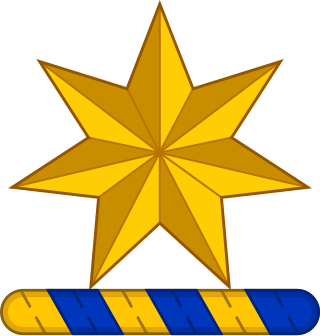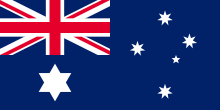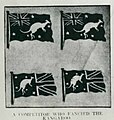
The Union Jack or Union Flag is the de facto national flag of the United Kingdom. The Union Jack was also used as the official flag of several British colonies and dominions before they adopted their own national flags. The flag continues to have official status in Canada, by parliamentary resolution, where it is known as the Royal Union Flag. However, it is commonly referred to in Canada as the Union Jack.

The current state flag of Tasmania was officially adopted following a proclamation by Tasmanian colonial Governor Sir Frederick Weld on 25 September 1876, and was first published in the Tasmanian Gazette the same day. The governor's proclamation here were three official flags, they being the Governor's flag, the Tasmania Government vessel flag, and a Tasmania merchant flag. Up until 1856 when Tasmania was granted responsible self-government, the Union flag and the British ensign were primarily used on state occasions.

The national flag of Malaysia, also known as the Stripes of Glory, is composed of a field of 14 alternating red and white stripes along the fly and a blue canton bearing a crescent and a 14-point star known as the Bintang Persekutuan. The 14 stripes, of equal width, represent the equal status in the federation of the 13 member states and the federal territories, while the 14 points of the star represent the unity among these entities. The crescent represents Islam, the country's state religion; the blue canton symbolises the unity of the Malaysian people; the yellow of the star and crescent is the royal colour of the Malay rulers, the red stripes represent bravery and the white stripes represent purity. It is in the stars and stripes family of flags.

The coat of arms of Australia, officially the Commonwealth Coat of Arms, is a formal symbol of the Commonwealth of Australia. It depicts a shield, containing symbols of Australia's six states, and is held up by native Australian animals, the kangaroo and the emu. The seven-pointed Commonwealth Star surmounting the crest also represents the states and territories, while golden wattle, the national floral emblem, appears below the shield.

The Commonwealth Star is a seven-pointed star symbolising the Federation of Australia which came into force on 1 January 1901.

The state flag of Victoria is a British Blue Ensign defaced by the state badge of Victoria in the fly. The badge is the Southern Cross surmounted by an imperial crown, which is currently the St Edward's Crown. The stars of the Southern Cross are white and range from five to eight points with each star having one point pointing to the top of the flag. The flag dates from 1870, with minor variations, the last of which was in 1901. It is the only Australian state flag not to feature the state badge on a round disc.

The current state flag of New South Wales was officially adopted in 1876. The flag is based on the defaced British Blue Ensign with the state badge located in the fly. The badge, based on the coat of arms, is a white disc with the cross of St George, a golden lion passant guardant in the centre of the cross and an eight-pointed gold star on each arm of the cross.

The coat of arms of Victoria is the official heraldic symbol of the Australian state of Victoria. Victoria was the second state of Australia to gain arms, granted on 6 June 1910 by royal warrant of King George V. The state had been named in 1851 after his grandmother, who reigned at the time. The current version of the arms was granted 28 March 1978 in the royal warrant issued by Queen Elizabeth II.

The Australian white ensign is a naval ensign used by ships of the Royal Australian Navy (RAN) from 1967 onwards. From the formation of the RAN until 1967, Australian warships used the British white ensign as their ensign. However, this led to situations where Australian vessels were mistaken for British ships, and when Australia became involved in the Vietnam War, the RAN was effectively fighting under the flag of another, uninvolved nation. Proposals were made in 1965 for a unique Australian ensign, which was approved in 1966, and entered use in 1967.

The Australian red ensign is the civil ensign of Australia, the flag of nationality flown by Australian registered ships. It is a red version of the national flag, which is mainly blue. Both flags resulted from the Commonwealth Government's 1901 Federal Flag Design Competition which required two entries: an ensign for Commonwealth Government use and another for the merchant navy. The winning design for the merchant ensign was based on the traditional British red ensign and featured the Southern Cross and Commonwealth Star.

Delta Crucis or δ Crucis, also identified as Imai, is a star in the southern constellation of Crux, and is the faintest of the four bright stars that form the prominent asterism known as the Southern Cross. This star has an apparent magnitude of 2.8, and its proper name was adopted by the International Astronomical Union on 10 August 2018. Imai is a massive, hot and rapidly rotating star that is in the process of evolving into a giant, and is located at a distance of about 345 light-years from the Sun.

The flag of the governor-general of Australia is an official flag of Australia and is flown continuously on buildings and other locations when the governor-general of Australia is present.

The Australian Defence Force Ensign is a flag of Australia which represents the tri-service Australian Defence Force. The design was formally recognised by the Australian Government as a flag of Australia with an amendment to the Flags Act 1953 passed on 14 April 2000.

The Australian Border Force Flag is the flag flown by Australian Border Force vessels and sometimes on ABF buildings. Any vessel acting in a customs capacity must fly this flag. The current version is an Australian National Flag with the words "AUSTRALIAN BORDER FORCE" added in bold between the Commonwealth Star and the lower part of the Southern Cross. This flag was adopted by regulations coming into force on 1 July 2015.
The Southern Cross or Crux, a constellation visible in the Southern Hemisphere, is depicted on flags and coats of arms of various countries and sub-national entities. This star constellation is visible mostly in the southern hemisphere and it therefore symbolises the southern location of its users.

The national flag of Australia is based on the British Blue Ensign—a blue field with the Union Jack in the upper hoist quarter—augmented with a large white seven-pointed star and a representation of the Southern Cross constellation, made up of five white stars. Australia also has a number of other official flags representing its states and territories, Indigenous peoples and government bodies.
Star polygons and polygonal compounds are the basis for numerous figures of significance in arts and culture. The figure may be the border or interior of the polygon, or one or more closed polygonal paths that include all of the border and also have some legs crossing the interior. The name is derived from the polygon's similarity to the diffraction spikes of astronomical stars, but specific uses may exploit the connection or not. Stars often represent the unity of states within a country when they are used as a part of the flag.

The Australian flag debate is a question over whether the Australian flag should be changed, particularly to remove the Union Jack from the canton, but also to possibly introduce a completely new design without the Southern Cross.
The following is a timeline of the flag of Australia.

























